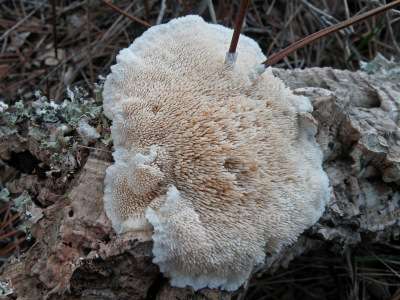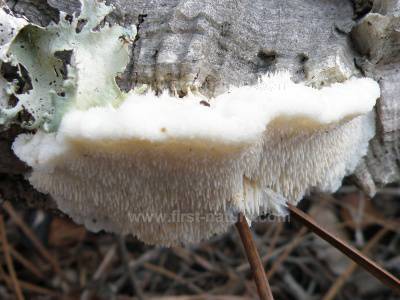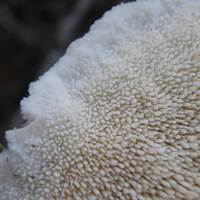Trees Birds Mammals Fish Amphibians Reptiles
Wild Algarve
Bookshop
Steccherinum ochraceum (Pers.) Gray
Phylum: Basidiomycota - Class: Agaricomycetes - Order: Polyporales (insertae sedis) - Family: Meruliaceae
Distribution - Taxonomic History - Etymology - Identification - Culinary Notes - Reference Sources

A wood-rotting crust fungus of deciduous hardwoods, this attractive fungus produces its spores on spines. It is uncommon in the UK but much more abundant in southern Europe.
Fallen oak trunks and large branches are particularly good places to try to find this pale ochre or pinkish crust-cum-bracket species, which has been 'parked' in its present position in the taxonomy of fungi - hence the term 'insertae sedis' mentioned in the taxonomic - Classification above.

The specimen shown here is young and pale; with age the central part of the fruitbody usually turns more intensely ochre.
Distribution
An uncommon resupinate tooth fungus, Steccherinum ochraceum is found occasionally in (mainly) southern parts of Britain and Ireland, but it is much more common in central and southern mainland Europe.
The wider distribution of this resupinate fungus includes many parts of North America.
Taxonomic history
In 1799, when Christiaan Hendrik Persoon described this toothed (hydnoid) fungus he gave it the binomial scientific name Hydnum ochraceum - a name which may have already been applied to this species by German naturalist Johann Friedrich Gmelin (1748 - 1804).
This fungus species was transferred to the genus Steccherinum in 1821 by British mycologist Samuel Frederick Gray (1766 - 1828).
Synonyms of Steccherinum ochraceum include Hydnum ochraceum Pers., Hydnum denticulatum Pers., Hydnum pudorinum Fr., Acia denticulata (Pers.) P. Karst., and Mycoleptodon ochraceum (Pers.) Pat.
Etymology
Steccherinum, the genus name, was established in 1821 by British mycologist Samuel Frederick Gray. The specific ochraceum is a reference to the ochre (orange-yellow) colour typical of this species.
Identification guide
 |
Fruitbody
Occasionally in bracket form but more often resupinate; roughly circular or oval when first forming, but expanding irregularly, often in peninsular form covering large areas; when shelf-like, extending horizontally to typically 1 to 2cm beyond the edge of the substrate; upper surface velvety almost white at edge but elsewhere ochre brown (often rather darker than the specimen shown here); fertile outer (lower) surface covered in short blunt spines; infertile surface white and velvety. |
| |
Spores
Ellipsoidal, smooth, 3-4.5 x 2-3µm; inamyloid
Spore print
White. |
Odour/taste |
Not significant . |
Habitat & Ecological role |
Saprobic on dead broadleaf trunks and fallen branches, particularly of oaks |
Season |
Summer and autumn. |
Culinary Notes
This fungus is tough and inedible (and quite rare throughout most of Britain and Ireland, so it should not be collected).
Reference Sources
Fascinated by Fungi, 2nd Edition, Pat O'Reilly 2016, reprinted by Coch-y-bonddu Books in 2022.
Dictionary of the Fungi; Paul M. Kirk, Paul F. Cannon, David W. Minter and J. A. Stalpers; CABI, 2008
Taxonomic history and synonym information on these pages is drawn from many sources but in particular from the British Mycological Society's GB Checklist of Fungi.
Top of page...
Fascinated by Fungi. Back by popular demand, Pat O'Reilly's best-selling 450-page hardback book is available now. The latest second edition was republished with a sparkling new cover design in September 2022 by Coch-y-Bonddu Books. Full details and copies are available from the publisher's online bookshop...